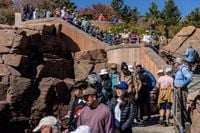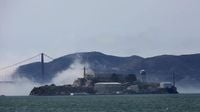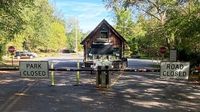On a crisp Friday morning in early October 2025, Great Falls Park in northern Virginia, usually bustling with families, hikers, and nature lovers, presented an unusual scene. The main entrance was closed, barricaded with three layers of barriers, and the parking lot was off-limits. But that didn’t deter determined visitors—many simply parked illegally along the narrow approach road, then clambered over or skirted the barricades to enter the park on foot.
This wasn’t an isolated incident. Across the United States, America’s national parks were caught in the crosshairs of a federal government shutdown that began on October 1, 2025. According to CNN, the Department of the Interior announced that parks would remain partially open, but with limited entrances, amenities, and staffing. For many, the reality was frustrating: visitor centers were closed, bathrooms were inaccessible, and park rangers—those ever-present guardians of safety and information—were nowhere to be seen.
“We are about to head into a very beautiful weekend. You better believe I’m extremely nervous,” Ed Stierli, Mid-Atlantic senior regional director for the National Parks Conservation Association (NPCA), told CNN. His anxiety wasn’t unfounded. Great Falls Park, with its dramatic cliffs and powerful Potomac River currents, is both a magnet for outdoor enthusiasts and a hotspot for accidents. “Now is not the time to climb over closed gates and risk your safety. It’s not good for the park and it’s not good for visitors,” Stierli warned.
The numbers behind the closures are staggering. More than 9,000 National Park Service employees were furloughed, leaving parks across the country with a skeleton crew—if any staff at all. While roads, trails, and open-air memorials generally remained accessible, the lack of rangers raised serious safety and security concerns. According to the National Park Service, as of October 5, 2025, events at national parks were also significantly limited due to the shutdown.
Advocacy groups sounded the alarm early. The Coalition to Protect America’s National Parks and the Association of National Park Rangers both criticized the decision to keep parks partially open, calling it “dangerous” and “irresponsible.” The Association of National Park Rangers warned that the absence of staff would increase the risk of vandalism and poaching. Stierli echoed these concerns, pointing out past incidents: during the previous major shutdown from December 2018 to January 2019, an arrowhead was stolen from the entrance to Shenandoah National Park. Theresa Pierno, president and CEO of the NPCA, recalled, “Parks were left open without enough staff. Landmarks were graffitied, artifacts stolen, Joshua Trees destroyed, fragile landscapes damaged by illegal off-roading, wildlife poached, and trash and human waste overflowed.”
For visitors, the shutdown brought a mix of confusion, disappointment, and irritation. CNN reporters visited three parks in the Washington, DC region—Great Falls Park, Manassas National Battlefield Park in Virginia, and Greenbelt Park in Maryland—finding a similar story at each. Visitor centers were shuttered, bathrooms locked, and staff scarce. The lack of clear communication left many unsure about how, or even if, they could access the parks.
Linda Mamoud, a medical student from Herndon, Virginia, was among those navigating the uncertainty. “I think it’s a little confusing and they should be more clear on entries and hours, and if we’re even allowed to come in,” she told CNN. After encountering the barricades at Great Falls, Mamoud turned to social media for advice. “I went on to Reddit threads and people said to just park at River Bend Park and then walk 40 minutes here on a different trail.” Official websites, she said, offered little guidance.
Out-of-state visitors felt the sting of disappointment acutely. Steve Hildreth, 84, had traveled from Idaho Falls, Idaho, to visit his son in Virginia, only to find the Manassas National Battlefield Park’s visitor center closed. “It’s a disappointment, after being here for the first time and not being able to see it,” he said. His wife, Lee, added, “It’s extremely disappointing, because this is probably the only time I’ll get to DC.” Another visitor at Manassas, hoping to use the visitor center to better understand the Civil War site, simply gave up and left when he saw the doors locked.
Safety concerns weren’t limited to the parks’ wild landscapes. At Greenbelt Park, a group of campers noticed the absence of Park Police patrols, which are normally a reassuring presence. “Some of us have a small concern” about safety, one camper admitted to CNN. Without rangers or police regularly checking on campers, even routine activities like hiking and camping took on an edge of uncertainty.
For others, the shutdown was a source of deep frustration—not just for the inconvenience, but for what it symbolized. Wendy, a hiker at Great Falls Park who declined to give her last name, was forced to walk two miles from a distant entry point. A furloughed government employee herself, she voiced a sentiment shared by many: “It’s frustrating. I mean, I pay to be a National Park member. I mean, it’s supposed to be for all of us.”
Behind the scenes, park advocates argued that the only safe and responsible solution was to close the parks entirely during the shutdown. The NPCA and other organizations pointed to the damage inflicted during past shutdowns: vandalism, theft, environmental harm, and increased risks to both visitors and wildlife. With staffing so thin, even the most basic maintenance—like emptying trash bins or cleaning restrooms—became impossible. And with no end to the shutdown in sight, the pressure on both the parks and their supporters continued to mount.
Meanwhile, the National Park Service acknowledged that events at national parks would be limited for the foreseeable future, compounding the sense of loss for both regular visitors and those who had traveled from afar. The shutdown, which began as a political impasse in Washington, rippled out to touch the lives of millions who find solace, adventure, and connection in America’s public lands.
As the days ticked by with no resolution in sight, one thing was clear: the shutdown was more than a bureaucratic inconvenience. It was a reminder of just how vital—and vulnerable—America’s national parks are, both as natural treasures and as places that belong to everyone.







